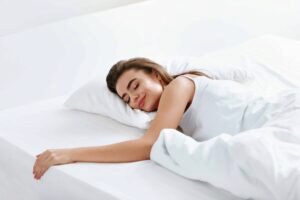Best Mattresses for Sciatica
Disclosure: By clicking on the product links in this article, Mattress Nerd may receive a commission fee at no cost to you, the reader. Read full disclosure statement.
Mattress Nerd consulted Vivian Eisenstadt, MAPT, CPT, MASP to ensure that this article met our editorial standards
If you’re suffering from sciatic nerve pain or lower back pain, your pain may worsen at night, making it difficult to achieve a good night’s sleep. The right mattress can significantly improve sleep quality. Many sciatica sufferers find that mattresses that conform closely, provide above-average pressure relief, and reduce motion help them rest easier and may improve nerve pain.
In this mattress review, we’re sharing the best mattresses for sciatica in 2024. We also share a buyer’s guide on shopping for a mattress if you suffer from this kind of pain. Keep reading to learn about our top picks and the most important considerations when shopping for a mattress for sciatica.
Disclosure: By clicking on the product links in this article, Mattress Nerd may receive a commission fee at no cost to you, the reader. Read full disclosure statement.
Best Mattresses for Sciatica
- Nectar—Editor’s Pick
- WinkBeds—Best for Heavyweight Sleepers with Sciatica
- Loom and Leaf—Best for Side Sleepers with Sciatica
- Brooklyn Bedding Signature Hybrid—Best Hybrid for Sleepers with Sciatica
- Puffy—Best for Lightweight Sleepers with Sciatica
- Amerisleep AS2—Best for Back and Stomach Sleepers with Sciatica
- Casper—Best for Average Weight Sleepers with Sciatica
Best Mattresses for Sciatica Video Review

The Nectar is a value memory foam mattress that excels at providing pressure relief and minimizing motion transfer. The medium-firm feel is ideal for cradling pressure points. Plus, it comes with a yearlong trial period and Lifetime warranty.
We recommend this mattress for the following sleeper types: Financing options are available for this mattress. The Nectar is a value memory foam mattress that excels at providing pressure relief and minimizing motion transfer. The medium-firm feel is ideal for cradling pressure points. Plus, it comes with a yearlong trial period and Lifetime warranty.
We recommend this mattress for the following sleeper types: Financing options are available for this mattress. The Nectar is a value memory foam mattress that excels at providing pressure relief and minimizing motion transfer. The medium-firm feel is ideal for cradling pressure points. Plus, it comes with a yearlong trial period and Lifetime warranty.
We recommend this mattress for the following sleeper types: Financing options are available for this mattress.Nectar Mattress
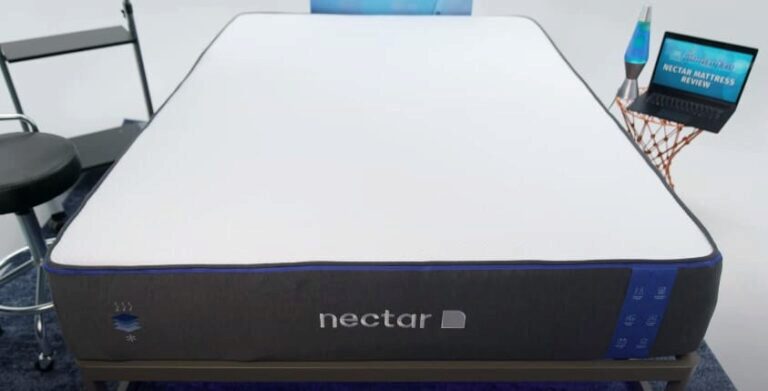
Material
Foam
Trial Period
365 nights
Shipping Method
Free shipping
Firmness
Medium-firm: 6/10
Warranty
Lifetime warranty
Price Range
$$$$$
Couples
This bed has great motion isolation so you will not feel your partner tossing and turning at night.
Back Pain
This bed is perfect for anyone suffering from back pain.
Back Sleeping
Ideal for lightweight and average weight back sleepers.
Side Sleeping
Ideal for heavyweight side sleepers.
Stomach Sleeping
Ideal for lightweight and average weight stomach sleepers.
Financing Options
Nectar Mattress

Material
Foam
Warranty
Lifetime warranty
Firmness
Medium-firm: 6/10
Shipping Method
Free shipping
Trial Period
365 nights
Price Range
$$$$$
Couples
This bed has great motion isolation so you will not feel your partner tossing and turning at night.
Back Pain
This bed is perfect for anyone suffering from back pain.
Back Sleeping
Ideal for lightweight and average weight back sleepers.
Side Sleeping
Ideal for heavyweight side sleepers.
Stomach Sleeping
Ideal for lightweight and average weight stomach sleepers.
Financing Options

Nectar Mattress
Material
Foam
Firmness
Medium-firm: 6/10
Trial Period
365 nights
Warranty
Lifetime warranty
Shipping Method
Free shipping
Price Range
$$$$$
Couples
This bed has great motion isolation so you will not feel your partner tossing and turning at night.
Back Pain
This bed is perfect for anyone suffering from back pain.
Back Sleeping
Ideal for lightweight and average weight back sleepers.
Side Sleeping
Ideal for heavyweight side sleepers.
Stomach Sleeping
Ideal for lightweight and average weight stomach sleepers.
Financing Options
The Nectar is a memory foam mattress with a medium-firm firmness setting and three layers of foam for pressure relief and motion isolation. The mid-level firmness (6/10) offers balanced support for side, back and stomach sleepers who are average or heavyweight, and it’s made with high-quality materials yet sold at a reasonable price point. The comfort foam layers of the Nectar include 2” of quilted memory foam and 2” of gel-infused memory foam.
These top layers conform closely to the body for a hug that can alleviate sciatic pain and prevent issues from pressure points in all three sleeping positions. Additionally, Nectar provides free shipping, a 365-night trial period and a Lifetime warranty with purchase. The combination of the bed’s pain-relieving foams, accessible price point and Nectar’s generous product policies earn it our Editor’s Pick for mattresses for sciatica.
Check out our full Nectar mattress review to learn more.
The WinkBed is available in four different firmness options. We particularly love it for hot sleepers because of its great temperature regulation, and it’s great for combination sleepers because of its responsiveness.
We recommend this mattress for the following sleeper types: Financing options are available for this mattress. The WinkBed is available in four different firmness options. We particularly love it for hot sleepers because of its great temperature regulation, and it’s great for combination sleepers because of its responsiveness.
We recommend this mattress for the following sleeper types: Financing options are available for this mattress. The WinkBed is available in four different firmness options. We particularly love it for hot sleepers because of its great temperature regulation, and it’s great for combination sleepers because of its responsiveness.
We recommend this mattress for the following sleeper types: Financing options are available for this mattress.WinkBed Mattress
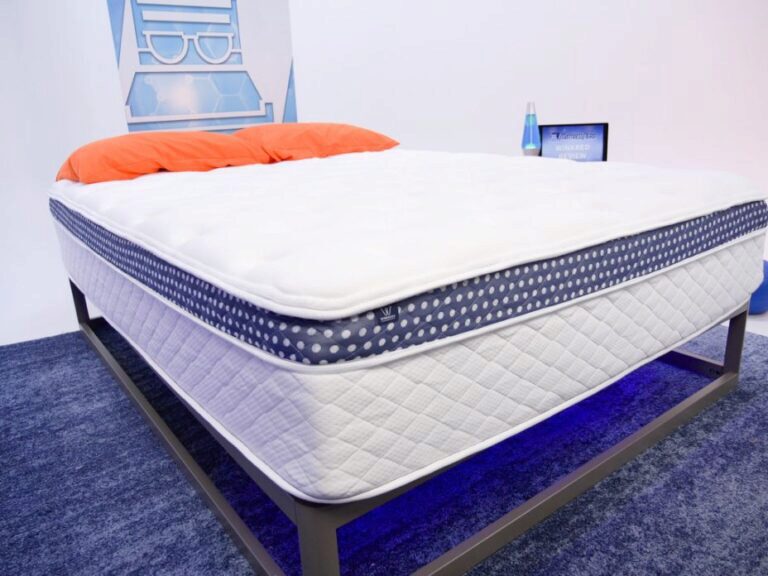
Material
Hybrid
Trial Period
120 nights
Shipping Method
Free shipping
Firmness
Multiple firmness options
Warranty
Lifetime warranty
Price Range
$$$$$
Hot Sleepers
If you often overheat while you sleep, this mattress should help you stay cool.
Seniors
This bed is perfect for senior sleepers.
Hip Pain
This bed is perfect for anyone suffering from hip pain.
Back Pain
This bed is perfect for anyone suffering from back pain.
Back Sleeping
Ideal for lightweight and average weight back sleepers.
Side Sleeping
Ideal for lightweight and average weight side sleepers.
Stomach Sleeping
Ideal for average weight stomach sleepers.
Financing Options
WinkBed Mattress

Material
Hybrid
Warranty
Lifetime warranty
Firmness
Multiple firmness options
Shipping Method
Free shipping
Trial Period
120 nights
Price Range
$$$$$
Hot Sleepers
If you often overheat while you sleep, this mattress should help you stay cool.
Seniors
This bed is perfect for senior sleepers.
Hip Pain
This bed is perfect for anyone suffering from hip pain.
Back Pain
This bed is perfect for anyone suffering from back pain.
Back Sleeping
Ideal for lightweight and average weight back sleepers.
Side Sleeping
Ideal for lightweight and average weight side sleepers.
Stomach Sleeping
Ideal for average weight stomach sleepers.
Financing Options

WinkBed Mattress
Material
Hybrid
Firmness
Multiple firmness options
Trial Period
120 nights
Warranty
Lifetime warranty
Shipping Method
Free shipping
Price Range
$$$$$
Hot Sleepers
If you often overheat while you sleep, this mattress should help you stay cool.
Seniors
This bed is perfect for senior sleepers.
Hip Pain
This bed is perfect for anyone suffering from hip pain.
Back Pain
This bed is perfect for anyone suffering from back pain.
Back Sleeping
Ideal for lightweight and average weight back sleepers.
Side Sleeping
Ideal for lightweight and average weight side sleepers.
Stomach Sleeping
Ideal for average weight stomach sleepers.
Financing Options
Mattresses for heavy sleepers with sciatica pain can be a challenge to find because many comfortable foam beds sink excessively or are not supportive enough. The WinkBed in its firmest setting is an exception, providing comfort through a gel memory foam layer with pocketed mini-coils and strong support through a pocketed coil support core encased in high-density polyfoam.
The bed also features a zoned support system, which provides more pressure relief in areas like the hips, shoulders, feet, and neck and more support through the torso. The WinkBed comes with a 120-night sleep trial, free shipping in the contiguous U.S. and a Lifetime warranty.
Read our full WinkBeds mattress review to learn more.
The Loom & Leaf by Saatva focused squarely at dethroning Tempur-Pedic as the main name in memory foam mattresses. Of all of the direct-to-consumer mattresses we’ve tried, the Loom & Leaf feels the most like Tempur-Pedic and at a fraction of the price.
We recommend this mattress for the following sleeper types: Financing options are available for this mattress. The Loom & Leaf by Saatva focused squarely at dethroning Tempur-Pedic as the main name in memory foam mattresses. Of all of the direct-to-consumer mattresses we’ve tried, the Loom & Leaf feels the most like Tempur-Pedic and at a fraction of the price.
We recommend this mattress for the following sleeper types: Financing options are available for this mattress. The Loom & Leaf by Saatva focused squarely at dethroning Tempur-Pedic as the main name in memory foam mattresses. Of all of the direct-to-consumer mattresses we’ve tried, the Loom & Leaf feels the most like Tempur-Pedic and at a fraction of the price.
We recommend this mattress for the following sleeper types: Financing options are available for this mattress.Loom & Leaf Mattress
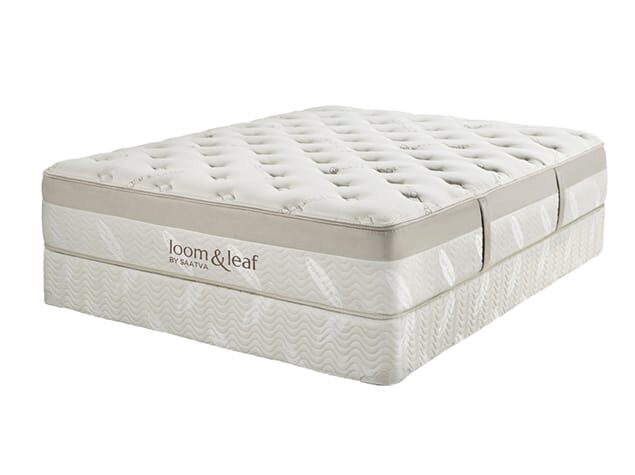
Material
Foam
Trial Period
365 nights
Shipping Method
Free shipping
Firmness
Medium-firm: 7/10
Warranty
Lifetime warranty
Price Range
$$$$$
Back Pain
This bed is perfect for anyone suffering from back pain.
Side Sleeping
Ideal for lightweight, average weight, and heavyweight side sleepers.
Financing Options
Loom & Leaf Mattress

Material
Foam
Warranty
Lifetime warranty
Firmness
Medium-firm: 7/10
Shipping Method
Free shipping
Trial Period
365 nights
Price Range
$$$$$
Back Pain
This bed is perfect for anyone suffering from back pain.
Side Sleeping
Ideal for lightweight, average weight, and heavyweight side sleepers.
Financing Options

Loom & Leaf Mattress
Material
Foam
Firmness
Medium-firm: 7/10
Trial Period
365 nights
Warranty
Lifetime warranty
Shipping Method
Free shipping
Price Range
$$$$$
Back Pain
This bed is perfect for anyone suffering from back pain.
Side Sleeping
Ideal for lightweight, average weight, and heavyweight side sleepers.
Financing Options
If you’re in the majority of sciatica sufferers who experience nerve pain on one side of the body, sleeping on your side can worsen symptoms. Side sleepers do best with a mattress that alleviates pressure points under the hips and shoulders, and the Loom & Leaf excels at this.
Its combination of memory foam and firmer support foams provide the perfect balance of pressure relief and support for lightweight and average weight sleepers in this position. While available in two firmness settings (5.5/10 and 8/10), we recommend the Relaxed Firm option for side sleepers, which will conform more closely. The Loom & Leaf comes with a 120-night sleep trial, a 15-year warranty, and ships free with White Glove Delivery in the contiguous U.S.
Read our full Loom & Leaf mattress review to learn more.
The Signature Hybrid mattress comes in three firmness options and is made with a slew of proprietary materials. Brooklyn Bedding knows their mattresses.
We recommend this mattress for the following sleeper types: Financing options are available for this mattress. The Signature Hybrid mattress comes in three firmness options and is made with a slew of proprietary materials. Brooklyn Bedding knows their mattresses.
We recommend this mattress for the following sleeper types: Financing options are available for this mattress. The Signature Hybrid mattress comes in three firmness options and is made with a slew of proprietary materials. Brooklyn Bedding knows their mattresses.
We recommend this mattress for the following sleeper types: Financing options are available for this mattress.Brooklyn Bedding Signature Hybrid Mattress
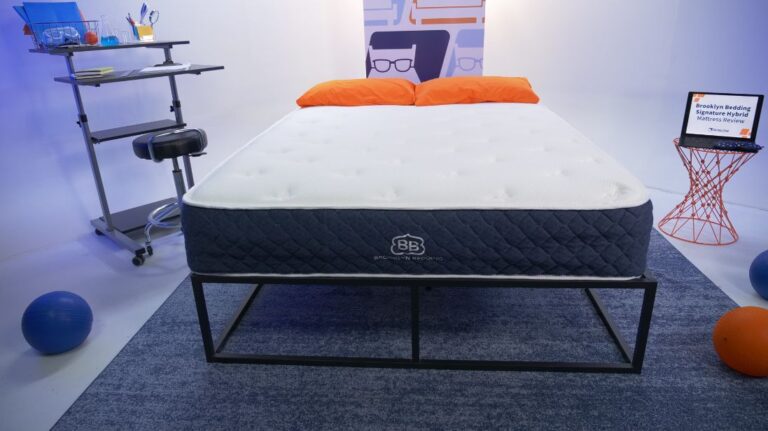
Material
Hybrid
Trial Period
120 nights
Shipping Method
Free shipping
Firmness
Multiple firmness options
Warranty
10-year warranty
Price Range
$$$$$
Couples
This bed has great motion isolation so you will not feel your partner tossing and turning at night.
Hip Pain
This bed is perfect for anyone suffering from hip pain.
Back Sleeping
Ideal for average weight back sleepers.
Financing Options
Brooklyn Bedding Signature Hybrid Mattress

Material
Hybrid
Warranty
10-year warranty
Firmness
Multiple firmness options
Shipping Method
Free shipping
Trial Period
120 nights
Price Range
$$$$$
Couples
This bed has great motion isolation so you will not feel your partner tossing and turning at night.
Hip Pain
This bed is perfect for anyone suffering from hip pain.
Back Sleeping
Ideal for average weight back sleepers.
Financing Options

Brooklyn Bedding Signature Hybrid Mattress
Material
Hybrid
Firmness
Multiple firmness options
Trial Period
120 nights
Warranty
10-year warranty
Shipping Method
Free shipping
Price Range
$$$$$
Couples
This bed has great motion isolation so you will not feel your partner tossing and turning at night.
Hip Pain
This bed is perfect for anyone suffering from hip pain.
Back Sleeping
Ideal for average weight back sleepers.
Financing Options
Foam mattresses are typically recommended for people with back pain, but hybrid options with thick conforming layers can provide just as much pain relief while also catering to sleepers who sleep hot or enjoy responsive sleeping surfaces.
The Brooklyn Bedding Signature Hybrid checks all of these boxes, with a 2” pressure-relieving polyfoam layer that is more responsive than memory foam but contours closer to the body than latex and a breathable support layer of pocketed coils. Shoppers can choose their firmness level (3.5/10, 5.5/10, or 7.5/10) based on their body type, sleeping position, and how much contouring they prefer. The Brooklyn Bedding Signature Hybrid comes with a 120-night sleep trial, free shipping and a 10-year warranty.
Read our full Brooklyn Bedding Signature Hybrid mattress review to learn more.
The Original Puffy is a three-layer foam mattress made with cooling gel-infused memory foam and motion isolating base foams. It has a medium-firm feel that blends contouring support with cushioning comfort.
We recommend this mattress for the following sleeper types: Financing options are available for this mattress. The Original Puffy is a three-layer foam mattress made with cooling gel-infused memory foam and motion isolating base foams. It has a medium-firm feel that blends contouring support with cushioning comfort.
We recommend this mattress for the following sleeper types: Financing options are available for this mattress. The Original Puffy is a three-layer foam mattress made with cooling gel-infused memory foam and motion isolating base foams. It has a medium-firm feel that blends contouring support with cushioning comfort.
We recommend this mattress for the following sleeper types: Financing options are available for this mattress.Puffy Cloud Mattress
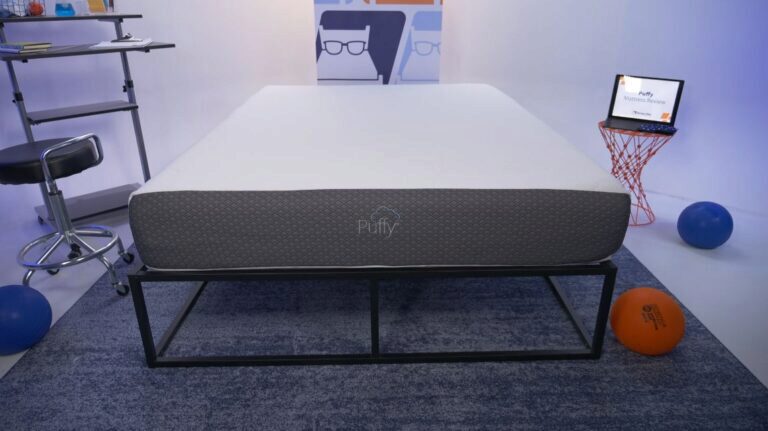
Material
Foam
Trial Period
101 nights
Shipping Method
Free shipping
Firmness
Medium-firm: 6/10
Warranty
Lifetime warranty
Price Range
$$$$$
Kids
This bed is perfect for young sleepers.
Back Pain
This bed is perfect for anyone suffering from back pain.
Back Sleeping
Ideal for lightweight and average weight back sleepers.
Side Sleeping
Ideal for lightweight and average weight side sleepers.
Financing Options
Puffy Cloud Mattress

Material
Foam
Warranty
Lifetime warranty
Firmness
Medium-firm: 6/10
Shipping Method
Free shipping
Trial Period
101 nights
Price Range
$$$$$
Kids
This bed is perfect for young sleepers.
Back Pain
This bed is perfect for anyone suffering from back pain.
Back Sleeping
Ideal for lightweight and average weight back sleepers.
Side Sleeping
Ideal for lightweight and average weight side sleepers.
Financing Options

Puffy Cloud Mattress
Material
Foam
Firmness
Medium-firm: 6/10
Trial Period
101 nights
Warranty
Lifetime warranty
Shipping Method
Free shipping
Price Range
$$$$$
Kids
This bed is perfect for young sleepers.
Back Pain
This bed is perfect for anyone suffering from back pain.
Back Sleeping
Ideal for lightweight and average weight back sleepers.
Side Sleeping
Ideal for lightweight and average weight side sleepers.
Financing Options
The Puffy is our choice for lightweight sleepers with sciatica pain because it hugs the body closely to alleviate pressure and pain along the spine, but it’s also supportive enough to prevent sagging and further discomfort. The Puffy has two foam comfort layers (4” in total) for an ultra-soft sleeping surface and is supported by a 6” high-density polyfoam core.
The dense core not only encourages spinal alignment, but it reduces motion transfer and noise, making the Puffy a nice choice for lightweight couples and co-sleepers as well. The Puffy comes with a 101-night sleep trial, a Lifetime warranty and free shipping to all 50 states.
See our full Puffy mattress review to learn more.
The AS2 is the best mattress from Amerisleep for stomach and back sleepers who like a medium-firm firmness level. This mattress is made to appeal to a wide range of sleepers and comes with a reasonable price point.
We recommend this mattress for the following sleeper types: Financing options are available for this mattress. The AS2 is the best mattress from Amerisleep for stomach and back sleepers who like a medium-firm firmness level. This mattress is made to appeal to a wide range of sleepers and comes with a reasonable price point.
We recommend this mattress for the following sleeper types: Financing options are available for this mattress. The AS2 is the best mattress from Amerisleep for stomach and back sleepers who like a medium-firm firmness level. This mattress is made to appeal to a wide range of sleepers and comes with a reasonable price point.
We recommend this mattress for the following sleeper types: Financing options are available for this mattress.Amerisleep AS2 Mattress
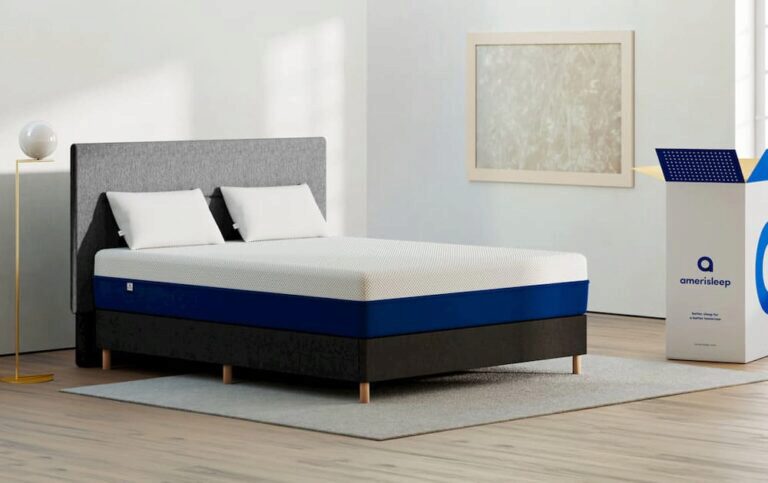
Material
Foam
Trial Period
100 nights
Shipping Method
Free shipping minus HI and AK
Firmness
Medium-firm: 7/10
Warranty
20-year warranty
Price Range
$$$$$
Back Pain
This bed is perfect for anyone suffering from back pain.
Back Sleeping
Ideal for lightweight and average weight back sleepers.
Stomach Sleeping
Ideal for lightweight and average weight stomach sleepers.
Financing Options
Amerisleep AS2 Mattress

Material
Foam
Warranty
20-year warranty
Firmness
Medium-firm: 7/10
Shipping Method
Free shipping minus HI and AK
Trial Period
100 nights
Price Range
$$$$$
Back Pain
This bed is perfect for anyone suffering from back pain.
Back Sleeping
Ideal for lightweight and average weight back sleepers.
Stomach Sleeping
Ideal for lightweight and average weight stomach sleepers.
Financing Options

Amerisleep AS2 Mattress
Material
Foam
Firmness
Medium-firm: 7/10
Trial Period
100 nights
Warranty
20-year warranty
Shipping Method
Free shipping minus HI and AK
Price Range
$$$$$
Back Pain
This bed is perfect for anyone suffering from back pain.
Back Sleeping
Ideal for lightweight and average weight back sleepers.
Stomach Sleeping
Ideal for lightweight and average weight stomach sleepers.
Financing Options
Firm mattresses typically don’t come to mind when people think of back pain relief, but firm doesn’t necessarily mean uncomfortable. In fact, sleep specialists recommend firmer mattresses like the Amerisleep AS2 for strict back and stomach sleepers, who need a supportive, even surface to prevent sinking in the hips, shoulders and mid-section.
The AS2 is an all-foam mattress that’s 12” tall and is the second firmest bed sold by Amerisleep. The top layer of comfort foam in the AS2 is where back and stomach sleepers with sciatica will find the most value: this 2” layer of memory foam has a classic, contouring feel. This layer allows sleepers to sink into the mattress for pressure relief without throwing the spine out of alignment.
The bed also has features that prevent overheating, like open-cell memory foam and a convoluted transitional layer for improved airflow, making it a great choice for back and stomach sleepers who sleep hot. The Amerisleep AS2 comes with a 100-night sleep trial, a 20 year warranty, and ships free to the contiguous U.S.
Check out our full Amerisleep AS2 mattress review to learn more.
If you’re in the market for a unique memory foam mattress, the Casper mattress may be for you. The Casper mattress offers great pressure relief, four foam layers, and targeted support. Capable of supporting all body types, the Casper is a universal mattress that can accommodate a variety of sleepers.
We recommend this mattress for the following sleeper types: Financing options are available for this mattress. "From the delivery of the box to the magical unfolding of the king size mattress to the first time laying on the bed, all smiles here! I have traveled for work for years, often sleeping on different beds at different hotels night after night."
If you’re in the market for a unique memory foam mattress, the Casper mattress may be for you. The Casper mattress offers great pressure relief, four foam layers, and targeted support. Capable of supporting all body types, the Casper is a universal mattress that can accommodate a variety of sleepers.
We recommend this mattress for the following sleeper types: Financing options are available for this mattress. "From the delivery of the box to the magical unfolding of the king size mattress to the first time laying on the bed, all smiles here! I have traveled for work for years, often sleeping on different beds at different hotels night after night."
If you’re in the market for a unique memory foam mattress, the Casper mattress may be for you. The Casper mattress offers great pressure relief, four foam layers, and targeted support. Capable of supporting all body types, the Casper is a universal mattress that can accommodate a variety of sleepers.
We recommend this mattress for the following sleeper types: Financing options are available for this mattress. "From the delivery of the box to the magical unfolding of the king size mattress to the first time laying on the bed, all smiles here! I have traveled for work for years, often sleeping on different beds at different hotels night after night."
Casper Original Demo Mattress
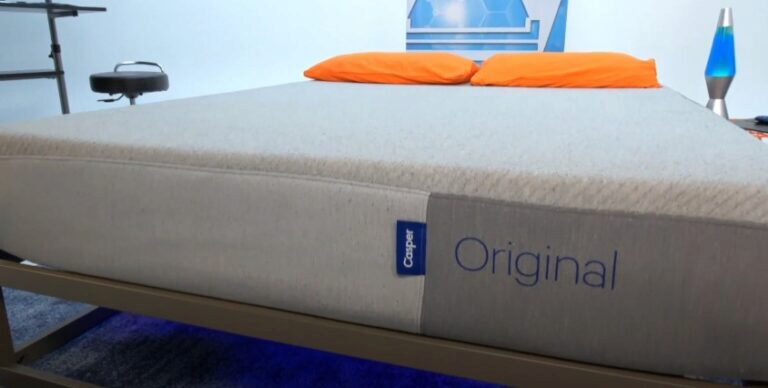
Material
Foam
Trial Period
100 nights
Shipping Method
Free shipping
Firmness
Soft: 6/10
Warranty
10-year limited warranty
Price Range
$$$$$
Couples
This bed has great motion isolation so you will not feel your partner tossing and turning at night.
Back Pain
This bed is perfect for anyone suffering from back pain.
Back Sleeping
Ideal for lightweight, average weight, and heavyweight back sleepers.
Side Sleeping
Ideal for lightweight, average weight, and heavyweight side sleepers.
Financing Options
Casper Original Demo Mattress

Material
Foam
Warranty
10-year limited warranty
Firmness
Soft: 6/10
Shipping Method
Free shipping
Trial Period
100 nights
Price Range
$$$$$
Couples
This bed has great motion isolation so you will not feel your partner tossing and turning at night.
Back Pain
This bed is perfect for anyone suffering from back pain.
Back Sleeping
Ideal for lightweight, average weight, and heavyweight back sleepers.
Side Sleeping
Ideal for lightweight, average weight, and heavyweight side sleepers.
Financing Options

Casper Original Demo Mattress
Material
Foam
Firmness
Soft: 6/10
Trial Period
100 nights
Warranty
10-year limited warranty
Shipping Method
Free shipping
Price Range
$$$$$
Couples
This bed has great motion isolation so you will not feel your partner tossing and turning at night.
Back Pain
This bed is perfect for anyone suffering from back pain.
Back Sleeping
Ideal for lightweight, average weight, and heavyweight back sleepers.
Side Sleeping
Ideal for lightweight, average weight, and heavyweight side sleepers.
Financing Options
People in the average weight group typically prefer beds with moderate firmness settings. The Casper mattress is considered medium-firm, with a firmness rating of 6/10. It offers moderate yet consistent conforming for sleepers in this weight category in all three primary sleeping positions.
The Casper’s two comfort layers (1.5” polyfoam and 2” of memory foam) are more responsive than traditional memory foam comfort layers to prevent excessive sinking and are more responsive than average, making it easier to change positions. The Casper comes with a 100-night sleep trial, a 10-year warranty and free shipping in the contiguous U.S.
See our full Casper mattress review to learn more.
Most Important Considerations for Sleepers with Sciatica
Mattress Firmness
Firmness and support go hand in hand, but firmness refers specifically to how soft or firm a mattress feels to an individual sleeper, making it a subjective mattress quality. Mattresses are rated by brands on a 1 to 10 scale with 1 being the softest and 10 being the firmest. Firm mattress options are more suitable for heavier sleepers, while soft mattresses are more suitable for lightweight sleepers. The firmness level that’s right for your sciatica pain will depend on your preferred sleeping position and body weight.
Related: Mattress Firmness Guide
Support
A mattress’ support is its ability to maintain an even flat surface underneath a sleeper’s body. As such, the right level of support will vary based on your bodyweight. Supportive mattresses encourage alignment in the shoulders, hips and spine, which help prevent additional pain points for sciatica sufferers. This is a key consideration for people with sciatica because, while they’re often drawn to softer surfaces, many plush beds lack proper support and can make the condition worse.
Conforming
Conforming refers to how a mattress sinks beneath the sleeper’s body to create impressions in the foam around the contours of their body, like the hips, shoulders, and head. A bed’s comfort layers and transitional layers influence conforming most, and hybrid mattresses and foam mattresses provide the most conforming.
The proper amount of conforming can provide pain relief because it eases mattress contact with pressure points. For example, side sleepers need highly conforming, softer mattresses that will provide deep pressure relief at the hips and shoulders.
Motion Isolation
Motion isolation is an important consideration if you suffer from sciatica and sleep with a partner or toss and turn frequently throughout the night as a result of discomfort from the condition. Foam mattresses isolate motion transfer exceptionally well, but some hybrid and latex mattresses minimize motion when constructed specifically to do so.
Related: Best Mattresses for Couples
What Type of Mattress is Best for Sciatica?
The main mattress types in the market include innerspring, all foam, hybrid, airbed and latex mattresses. Foam and hybrid models tend to be the best mattresses for sciatica, as their thicker comfort layers conform closely to the body for pressure and pain relief.
Memory Foam Mattresses
Foam beds are made entirely of different types of foam, including memory foam, polyfoam and proprietary foams with varying densities and special features.Foam mattresses are known for their “hug,” which relieves pressure, but they also tend to trap body heat. If breathability is a concern and you’re set on a foam mattress, consider all-foam beds with cooling properties, like convoluted layers, gel-infused foams and lower-density top layers. Related: Best Memory Foam Mattresses

Hybrid Mattresses
Hybrid mattresses combine a coil support system with a foam comfort layer. These beds marry the responsiveness and durability of innerspring mattresses with the pressure relief and comfort of foam mattresses.The pocketed coil layer also helps these beds sleep cooler, making them a great choice for couples or those who sleep hot. Sciatica sufferers who like a bouncier feel to their mattress or sleep hot but want above-average pressure relief should look for hybrid models with thick, conforming foam layers. Related: Best Hybrid Mattresses

Latex Mattresses
Like the other types, latex mattresses are usually constructed with a dense support layer and are topped with increasingly cushy comfort layers. They provide some of the pressure relief of memory foam beds with the high responsiveness of an innerspring, making them great options for combo sleepers (people who switch positions frequently) with sciatica. If you have a lower budget, though, it may be a challenge to find a great latex bed for a low price. Related: Best Latex Mattresses

Innerspring Mattresses
While innerspring mattresses are a great option for some because of their wide availability and general affordability, they may not be the best option for those with sciatica because they don’t usually provide the same pressure relief that the other three mattress types do. However, if you already have an innerspring and want to hang onto it, adding one of our best memory foam mattress toppers can help get the firmness level to a more comfortable place. Related: Best Innerspring Mattresses

How Your Sleeping Position Affects Sciatica
The path to alleviating pressure and improving spinal alignment varies for each sleep position, so it’s important to know which position you wind up in for the majority of the night.
Side Sleepers with Sciatica
The main contact points for side sleepers to be aware of are the hips and the shoulders. That’s because they are the heaviest parts of a side sleeper’s body that touch the mattress surface. When a bed is too firm, the hips and shoulders are not able to sink into the surface and the result is excess pressure; when a mattress is too soft, they can sink too far in and throw the spine out of alignment, which can exacerbate sciatica symptoms.
If you’re a side sleeper and you suffer from sciatica, it is especially important to make sure you get the firmness right. Something right down the middle between soft and firm can help prevent or reduce pain flare ups in sensitive areas.
Another important consideration for those with sciatica is which side to sleep on. Our expert reviewer Vivian Eisenstadt explains, “If you’re in the majority of sciatica sufferers who experience nerve pain on one side of the body, sleeping on your side can worsen symptoms…If you are going to sleep on your side, sleep with the affected side towards the ceiling and a pillow between your legs.”
For more tips, take a look at our article on how to properly sleep on your side. And be sure to take a look at our best mattress for side sleepers roundup.
Back Sleepers with Sciatica
Much like side sleepers, back sleepers with sciatica need to find a good balance between plush and firm. Where a side sleeper might look for a mattress around the 5/10 region on the firmness scale, a back sleeper may want to consider something closer to 6/10. That is because when a back sleeper’s hips sink just a little bit too far below the surface, a good deal of pressure is placed on the lower back—definitely something that those with sciatica want to avoid. Our list of best mattresses for back sleepers have some wonderful options for you to consider.
Stomach Sleepers with Sciatica
Generally, we consider stomach sleeping to be the least healthy option long term. This holds true for stomach sleepers with sciatica, as of all the positions it is the most likely to put stress on the lower back.
That said, if you’re not willing to try and change your sleeping position you should look at mattresses on the firm end of the scale—around 7/10. The higher the firmness, the more your hips will be supported and your lower back stress free.
Make sure you look at our article on how to properly sleep on your stomach, and check out our list of best mattresses for stomach sleepers.
Combination Sleepers with Sciatica
Combination sleepers are those who switch positions frequently, a common trait among people with sciatica. Unlike the other positions, firmness isn’t necessarily the most important factor for combo sleepers. Rather, they should look out for mattresses with high responsiveness to allow for better ease of movement. Hybrids and latex beds are good options here.
Related: Best Mattresses for Combination Sleepers
Get Better Sleep with Back Pain
Final Considerations
- What is Your Budget?—Consider your budget and rule out any beds that exceed it. Keep in mind that certain mattress types, like foam models, cost less than others. Be sure to account for shipping costs.
Related: Best Affordable Mattresses
- How Thick Should the Mattress Be?—The overall thickness of the mattress is a key consideration, as some sciatica sufferers may have trouble getting in and out of bed yet thicker mattresses with tall comfort layers tend to provide better conforming. Look for mattresses that are at least 10” tall and consider the bed’s edge support performance if you struggle getting in or out of bed.
- Are Purchase Policies Important to You?—Choosing a mattress with the intention to alleviate pain at night can be anxiety-inducing. What if you choose the wrong one? What if it worsens symptoms? To protect against stress and ensure you will eventually land on the right mattress, select a bed with a sleep trial that’s at least four weeks long and warranty coverage that will last the duration of the mattress’ lifespan (at least seven years, on average).
Conclusion
Sciatic nerve pain is not easy to combat, and while medication, medical advice and physical therapy may be the primary factors that move the needle on your pain levels and overall lifestyle, the right mattress may improve your sleep and pain.
Make a list of the sciatica symptoms you experience (bladder control, tossing and turning, low back pain, numbness), consult your doctor about the mattress type and features that might be best for you, and then use your list of the best mattresses for sciatica as a starting point as you select a mattress with the goal of pain relief and better sleep.
If you aren’t quite ready to wrap up your research process, consider taking a look at our informational articles on spine alignment and sleep, and sleeping with lower back pain,
| Mattress | Award |
| Nectar | Editor’s Pick |
| WinkBeds | Best for Heavyweight Sleepers with Sciatica |
| Loom and Leaf | Best for Side Sleepers with Sciatica |
| Brooklyn Bedding Signature Hybrid | Best Hybrid for Sleepers with Sciatica |
| Puffy | Best for Lightweight Sleepers with Sciatica |
| Amerisleep AS2 | Best for Back and Stomach Sleepers with Sciatica |
| Casper | Best for Average Weight Sleepers with Sciatica |
Vivian Eisenstadt is part of our panel of medical expert contributors on the subject of sleep health. They provide important perspectives on the topics we discuss to help make our content as accurate and dependable as possible. They do not personally endorse any products, nor are they associated with any brands featured in our review content.


